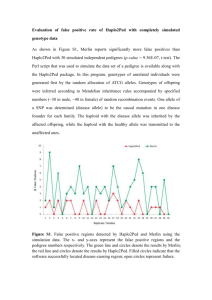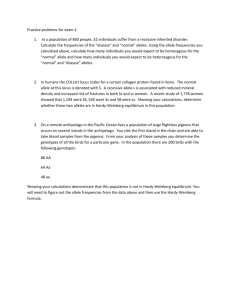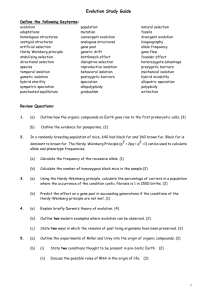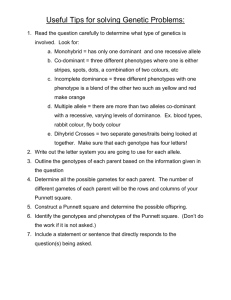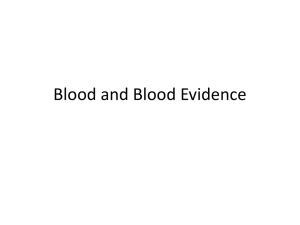Population genetics problems
advertisement
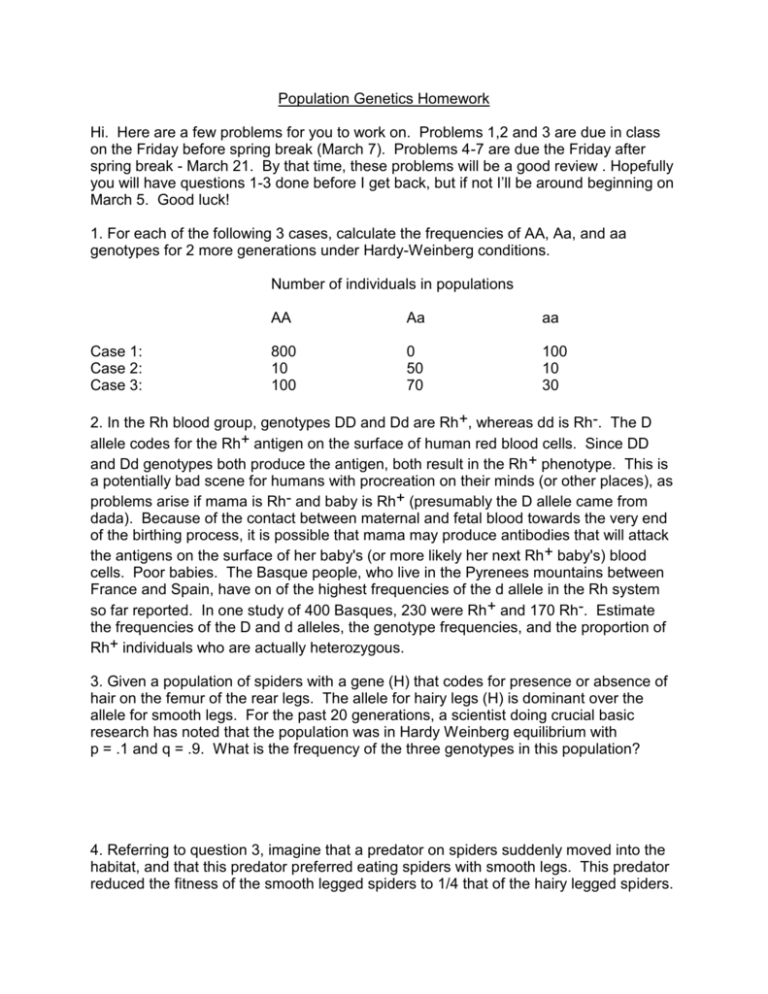
Population Genetics Homework Hi. Here are a few problems for you to work on. Problems 1,2 and 3 are due in class on the Friday before spring break (March 7). Problems 4-7 are due the Friday after spring break - March 21. By that time, these problems will be a good review . Hopefully you will have questions 1-3 done before I get back, but if not I’ll be around beginning on March 5. Good luck! 1. For each of the following 3 cases, calculate the frequencies of AA, Aa, and aa genotypes for 2 more generations under Hardy-Weinberg conditions. Number of individuals in populations Case 1: Case 2: Case 3: AA Aa aa 800 10 100 0 50 70 100 10 30 2. In the Rh blood group, genotypes DD and Dd are Rh +, whereas dd is Rh-. The D allele codes for the Rh+ antigen on the surface of human red blood cells. Since DD and Dd genotypes both produce the antigen, both result in the Rh + phenotype. This is a potentially bad scene for humans with procreation on their minds (or other places), as problems arise if mama is Rh- and baby is Rh+ (presumably the D allele came from dada). Because of the contact between maternal and fetal blood towards the very end of the birthing process, it is possible that mama may produce antibodies that will attack the antigens on the surface of her baby's (or more likely her next Rh + baby's) blood cells. Poor babies. The Basque people, who live in the Pyrenees mountains between France and Spain, have on of the highest frequencies of the d allele in the Rh system so far reported. In one study of 400 Basques, 230 were Rh + and 170 Rh-. Estimate the frequencies of the D and d alleles, the genotype frequencies, and the proportion of Rh+ individuals who are actually heterozygous. 3. Given a population of spiders with a gene (H) that codes for presence or absence of hair on the femur of the rear legs. The allele for hairy legs (H) is dominant over the allele for smooth legs. For the past 20 generations, a scientist doing crucial basic research has noted that the population was in Hardy Weinberg equilibrium with p = .1 and q = .9. What is the frequency of the three genotypes in this population? 4. Referring to question 3, imagine that a predator on spiders suddenly moved into the habitat, and that this predator preferred eating spiders with smooth legs. This predator reduced the fitness of the smooth legged spiders to 1/4 that of the hairy legged spiders. a) What will be the frequency of smooth legged spiders the next generation? b) What will be the frequency of the h allele next generation? c) What will be the frequency of the h allele in 3 generations? 5. H.B.D. Kettlewell marked and released 393 light pepper moths (dd) and 406 dark pepper moths into unpolluted woods near Dorset, England. He waited a few days and then went back to those woods and recaptured 54 light and 19 dark moths. Calculate the fitness and selection coefficient on the two forms of the moth. 6. In Nigeria 29 individuals were found to be homozygous for sickle cell hemoglobin (HbS/HbS), 2993 were HbA/HbS heterozygotes and 9365 were HbA/HbA. Calculate the Hardy-Weinberg equilibrium to find out what those numbers should have been if the population were experiencing no selection (Carry out calculations to nearest .0001). 7. The numbers in problem 6 can be used to calculate fitness of the genotypes. The expected numbers if no selection (Hardy-Weinberg equilibrium) can represent what the population would be before selection and the observed numbers of each genotype represent what the population is like after selection. Given that, calculate the fitness and selection coefficients on each genotype.




